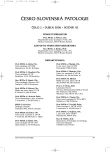The Subacute Angiohypertrophic Myelomalacia Foix-Alajouanine – a Rare Disease?
Authors:
M. Čegan; L. Čeganová; J. Štěrba; J. Dvořáčková; J. Ehrmann 1; R. Koďousek 1
Authors‘ workplace:
CGB laboratoř spol. s r. o., Ostrava
; Ústav patologické anatomie, LF, Univerzita Palackého, Olomouc
1
Published in:
Čes.-slov. Patol., 42, 2006, No. 2, p. 76-80
Category:
Overview
The subacute angiohypertrophic myelomalacia Foix-Alajouanine was first described by French authors in 1926 and belongs to the wider category of CNS vascular malformations. Both individual casuistics and larger sets of patients with this disease can be found in literature scarcely. We are presenting three necroptic cases of subacute angiohypertrophic myelomalacia (Foix-Alajouanine) that were mistakenly diagnosed clinically, once as metastatic lesion of spinal canal, once as amyotrophic lateral sclerosis, and once as inflammatory lesion of spinal cord. The histologic finding is dominated by myelomalacia of varying extent with varicosely dilated, constricted or even occluded arterialized both extra - and intramedullary veins, sporadically coupled with secondary thrombi. Clinical diagnostics is difficult and requires spinal angiography. According to literature data, it is presumable that this disease is not as rare as it may seem at first sign.
Key words:
vascular malformations – central nervous systém – subacute angiohypertrophic myelomalacia
Labels
Anatomical pathology Forensic medical examiner ToxicologyArticle was published in
Czecho-Slovak Pathology

2006 Issue 2
Most read in this issue
- Argyrophilic Grain Disease: Case Report of the First Two Cases in the Czech Republic and Review of the Literature
- Tumoriform Endometriosis of the Urinary Bladder in Advanced Pregnancy
- Dedifferentiated Mixed Stromal-Smooth Muscle Tumor of the Uterus. Report of a Case
- Epithelioid Hemangioma of the Foot
